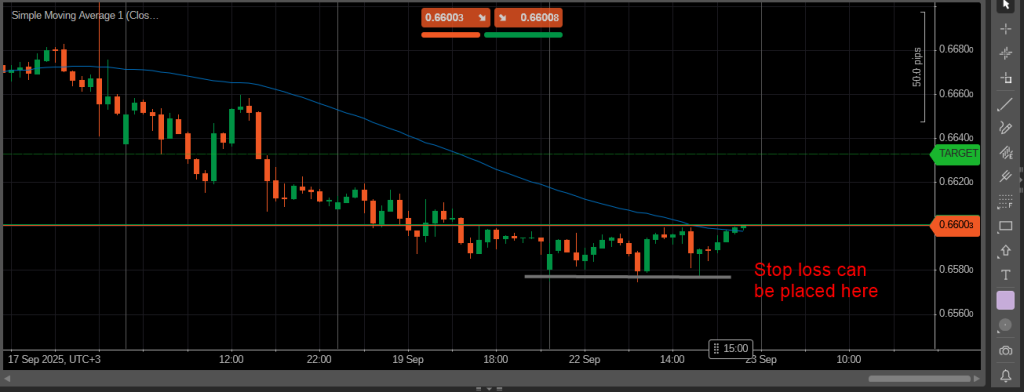I still remember the first time I watched a trade go completely against me. It was painful, frustrating, and a little scary — but it taught me one of the most important lessons in trading: never underestimate the power of a stop loss. A stop loss isn’t just a tool that closes losing trades automatically; it’s my safety net, my risk manager, and one of the key reasons I can trade with confidence.
Over time, I’ve learned that setting stop losses correctly can save not only my capital but also my peace of mind. In this article, I’ll share how I approach stop losses, where I place them, how I use the risk-to-reward method, and how spreads can affect their effectiveness. Whether you trade forex, stocks, or crypto, mastering stop losses is essential to trading smart and staying in the game.
What Is a Stop Loss and How Does It Work?
When I first heard about stop losses, I thought of them as just a number on the chart, a level where the broker automatically closes a losing trade. But over time, I realized they’re much more than that. A stop loss is my way of controlling risk, protecting my capital, and preventing small losses from turning into big ones.
In practice, a stop loss is an order I set at a price level that I’m willing to risk. If the market hits that level, the trade automatically closes, which means I don’t have to panic or watch the trade minute by minute. For example, in forex or stock trading, I often set a stop loss just below a support level or above a resistance level, depending on whether I’m going long or short.
Using stop losses has taught me discipline. I don’t move them around impulsively or hope the market will turn in my favor, they are part of a well-thought-out plan. Without a stop loss, even the best trading strategy can fail, because unexpected market moves can wipe out gains in seconds.
Types of Stop Losses
Over time, I’ve realized that not all stop losses are created equal. Depending on the trade, the market, and my strategy, I use different types of stop losses to manage risk effectively.
The most basic is the fixed stop, where I set a specific price level and leave it there until the trade closes. It’s simple and works well for straightforward setups, but it doesn’t adjust if the market moves in my favor.
Then there’s the trailing stop, which I really like because it moves with the price. As the trade becomes profitable, the trailing stop locks in gains automatically. It’s like having a safety net that keeps stretching as you climb — it protects my profit while still giving the trade room to grow.
I also use volatility-based stops sometimes, especially in forex and crypto trading. By measuring how much the market typically moves, I can set a stop that’s less likely to get triggered by normal price fluctuations. Finally, there’s the percentage-based stop, which I use to risk a fixed portion of my account on each trade.
By knowing the different types and choosing the right one for each trade, I feel much more confident and disciplined in my trading approach.
Where to Place Stop Losses

Deciding where to place a stop loss is one of the most important parts of my trading. I usually start by looking at key technical levels like support and resistance, recent highs and lows, and overall market structure. These levels often act as natural barriers, so placing a stop just beyond them can make sense.
I also consider market volatility. Using tools like the average true range (ATR) helps me determine a dynamic stop that adjusts to normal price fluctuations, rather than just a fixed number of pips. This way, my stop isn’t triggered by minor market noise.
Another crucial factor I use is the risk-to-reward method. For every trade, I calculate how much I’m willing to risk versus the potential reward. This helps me place my stop loss at a level that aligns with my trading plan, ensuring that even if the trade hits the stop, the loss is manageable relative to the possible gain. Combining technical analysis with risk-to-reward considerations has made my stop loss placement much more effective and disciplined.
Stop Losses and Spreads
One thing I quickly learned in trading is that spreads can have a big impact on how stop losses work. The spread is the difference between the buy and sell price, and it affects how far the price has to move before my stop is triggered.
When I trade instruments with high spreads, like some exotic forex pairs, I place my stop a little farther away to avoid getting stopped out by normal market fluctuations. On the other hand, with low-spread instruments, such as major forex pairs or highly liquid stocks, I can afford tighter stops.
Considering spreads also ties into my risk-to-reward calculations. If I ignore the spread, I might set a stop that is too close and get stopped out unnecessarily, or set one that’s too wide and risk more than planned. By factoring spreads into my stop loss placement, I can manage risk more effectively and avoid surprises that could hurt my trading results.
Common Stop Loss Mistakes and How I Avoid Them
Over the years, I’ve learned that setting stop losses is just as much about discipline as it is about strategy. Making mistakes with stops can turn a good trade into a loss, but avoiding them helps me protect my capital and trade more confidently. Here are the most common mistakes I’ve seen — and how I personally deal with them:
- Setting stops too tight. Normal market fluctuations trigger the stop prematurely. I avoid this by analyzing recent volatility and placing stops at levels that give the trade enough room.
- Setting stops too wide. I risk more than necessary, hurting my risk-to-reward ratio. I avoid this by combining technical levels and risk-to-reward calculations to choose logical stop points.
- Moving stops impulsively. I sometimes feel tempted to adjust stops when the trade isn’t going my way. I avoid this by trusting my plan and only adjusting stops for trailing purposes when the trade moves in my favor.
- Ignoring market volatility. Stops that don’t account for normal swings can trigger unnecessarily. I avoid this by using ATR or historical volatility to place stops that fit current market conditions.
- Not considering spreads. Stops that ignore spreads can cause premature exits. I avoid this by factoring in the spread when setting stop levels, especially in high-spread or low-liquidity markets.
- Skipping the risk-to-reward check. I place stops without confirming the potential reward justifies the risk. I avoid this by always calculating risk-to-reward before entering a trade to ensure my stops align with a profitable strategy.
Tips for Using Stop Losses Effectively
Over time, I’ve discovered that having a stop loss isn’t enough — how you use it makes all the difference. Here are the strategies I follow to make my stops work for me:
- Always plan your stop before entering a trade. I decide my stop level and risk-to-reward ratio in advance, so I don’t make impulsive decisions once the trade starts.
- Combine stops with technical analysis. I place stops near support or resistance levels, recent highs or lows, or key trend lines to give them a logical basis rather than setting them randomly.
- Account for market volatility. I use ATR or historical volatility to avoid stops that are too tight, which helps me stay in trades during normal price fluctuations.
- Adjust stops only to lock in profits. I use trailing stops when trades move in my favor, but I avoid moving them closer impulsively, which can lead to exiting trades too early.
- Factor in spreads. I always consider the spread of the instrument I’m trading so that my stop isn’t triggered unnecessarily, especially in markets with high spreads or low liquidity.
- Review and refine your approach. I regularly check how my stop placements perform and adjust my strategy based on what I learn from past trades. This helps me continuously improve risk management.
Conclusion: How I Use Stop Losses to Trade Smarter
Stop losses have become one of the most important tools in my trading. They protect my capital, help me manage risk, and keep me disciplined even when the market moves against me. Over the years, I’ve learned that setting a stop isn’t just about picking a price level, it’s about planning, considering volatility and spreads, and aligning with my risk-to-reward ratio.
Using stops effectively has allowed me to trade with confidence, knowing that even if a trade goes wrong, my losses are controlled. By combining technical analysis, risk management strategies, and careful planning, I can focus on finding good opportunities rather than worrying about unexpected market moves. For me, mastering stop losses is not just about surviving in the markets, it’s about trading smarter and building consistent results.




